The Gordon Relief Campaign (1884-85)
A first-hand account by the commander of the Talahawiya steamer
by James Baxendale O.B.E. ©
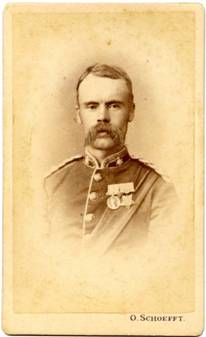
Photograph of Major Lionel Trafford with Khedive Bronze Star 1
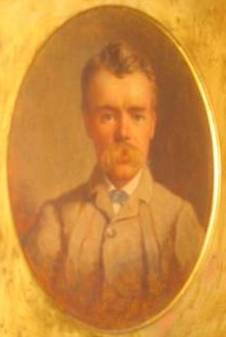
Self-portrait of Lionel Trafford
Lionel Trafford deserved more recognition than he got. He is not only a brave and capable solider, but a good comrade…2
“On 27th of January the rescuers came in sight of Khartoum and under the fire of the enemy. Many of their perilous adventures seem to belong to romance rather than to reality. But the scene that appeals to the imagination above all the others is that where with both banks ablaze with musketry and artillery, the black smoke pouring though the shot-holes in the funnels, the water rising in spurts from the bullets, the men who had come so far and braved so much stared at the palace roof and, seeing no flag flying, knew that all was over and that they had come too late.”
Introduction
The ill-fated attempt by two steamers to rescue General Gordon in Khartoum has been called by the historian, Jan Morris, ‘one of the great moments of the imperial story’.4 A number of books have been written about the Gordon Relief Campaign.5 But only one6 appears to have made any use of the first-hand account by the commander of one of the two steamers that made the final dash to Khartoum, which arrived two days too late to rescue Gordon: namely, that of Captain (later Major) Lionel Trafford of the 35th (Royal Sussex) Regiment.
Lionel, a soldier and an artist, produced two accounts of the campaign. Both are lavishly illustrated with his watercolours. The first version appears to be his original version, which he wrote either contemporaneously, or shortly after, the events happened. They were found at the time of the sale of his house, Hill Court, in 1982, but are incomplete, ending with the steamers about to depart for Khartoum.7 The latter, or ‘official’, version, is beautifully bound. Lionel gave it to his Regiment in 1892:
Michaelchurch Court, Hereford
Sept 13th 1892
Dear Colonel
I must ask you and the officers of the 1st Bn to look with indulgent eyes on the wretched scribble in this volume. It is taken from a short diary I kept while in the Soudan and all the drawings with one or two exceptions are copied from those done on the spot, the few exceptions will be very apparent. As my space was limited I tried to keep more or less to the Diary form of writing but as my subject was large in doing so I am afraid that I have sometimes sacrificed clearness for brevity. But what I must most apologise for is the writing; when I once started all the events crowded back on me with such rapidity that in spite of myself my pen tried to keep pace with my recollections and with the following disastrous effect.
Truly yrs
Lionel Trafford8
Lionel also painted a number of sketches during the campaign, almost certianly contemporaneously, which he kept in an album.9
Early Years
Lionel Trafford was born in Gibraltar on 1 November 1855.10 He was the third of four sons and two daughters. He was from a well-off Herefordshire family, his great grandfather on his maternal side, Benjamin Rawson, having made a considerable fortune in the early years of the nineteenth century, in the production of vitriol in Bradford.
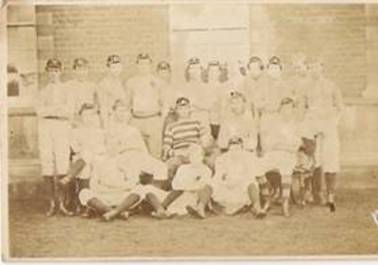
Football Caps, Wellington College,
Christmas 1870
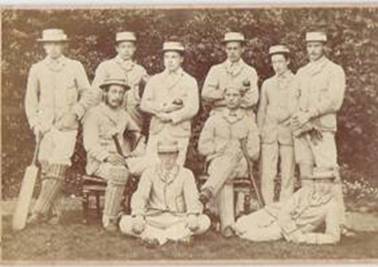
Cricket Eleven, Wellington College,
Midsummer 187111
Whilst his three brothers were educated at either Harrow or Bradfield College (and subsequently at Oxford or Cambridge), Lionel went to Wellington College. He left Wellington, aged sixteen, in 1872.12 The reason for leaving at sixteen may well have been related to the severe debts which his eldest brother, Ned, had incurred whilst at Cambridge in 1871-72. His father had had to pay the debts off, leaving him considerably poorer. 13 Ned was partially disinherited and sent off to America in 1874.
However, thanks to the trust left by Benjamin Rawson, Lionel was not left penniless. Indeed, with Ned’s partial disinheritance, Lionel was considerably better off, standing to inherit in Ned’s place the Lancashire estates (which he finally did on the death of his aunt, Elizabeth Rawson, in 1890).14
As the third son, it was a natural step for Lionel to join the army. His father had been in the army, as had his grandfather, Major General Thomas Samuel Trafford, who had fought in the Peninsular Wars, as well as various other relations. In 1874, his sister, Clare, had married Edward Hopton (later Major-General Sir Edward Hopton), who had fought at the Siege of Sebastapol in the Crimea, and at the Siege of Lucknow in 1858, during the Indian Mutiny.
Lionel initially joined the Nottingham or Royal Sherwood Foresters Militia – in which his wayward brother, Ned, was at that time briefly a Lieutenant – as a Sub-Lieutenant on 11 February 1874.15 He was subsequently promoted to Lieutenant.16
35th (Royal Sussex) Regiment
On 20 November 1875, Lionel was commissioned as a Lieutenant in the 35th (Royal Sussex) Regiment.17 His first posting, on 2 February 1876, was to the West Indies, including Jamaica, where he remained until February 1879.

Barbados, February 187618
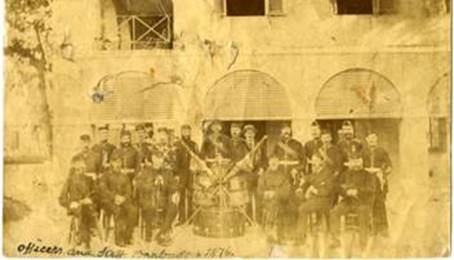
Officers and staff of the Royal Sussex Regiment, Barbados, 187619
On 14 February 1877, his brother, Harry, wrote to Lionel in Newcastle, Jamaica:
His father wrote in a similar vein:
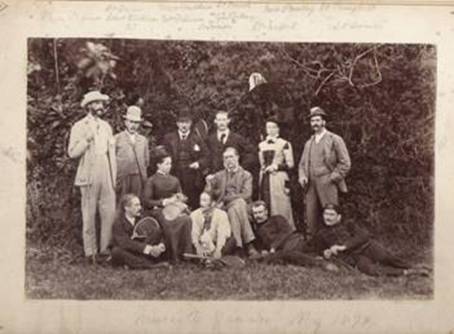
Newcastle, Jamaica, May 1878
Lionel is second from the right, lying down21
From March 1879 to August 1882, Lionel was based in Malta with the 35th Foot.22 Then, on 5 August 1882, he was sent with his Regiment to Egypt to take part in the Egyptian expedition of that year.
Egypt was at that time in the middle of the Arab nationalist uprising against the Khedive, led by Colonel Ahmad Arabi. The second Anglo-Egyptian War had started with the bombardment of Alexandria by the British on 11 July 1882. Lionel landed near Ramleh with the 1st Battalion of the Royal Sussex Regiment in August, but was held up for five weeks by Arabi’s forces. Consequently, he did not take part in the decisive battle of Tel el-Kebir on 12 September 1882. For his part in the operations at Ramleh,23 Lionel received a medal and the Khedival Bronze Star.24 The following year, Lionel was promoted to Captain. 25
The Regiment remained in Egypt following the suppression of the uprising, when the country came in effect under Egyptian rule. At some stage – certainly, according to Lionel’s diary, by July 1884 – the Regiment was posted to Aswan.
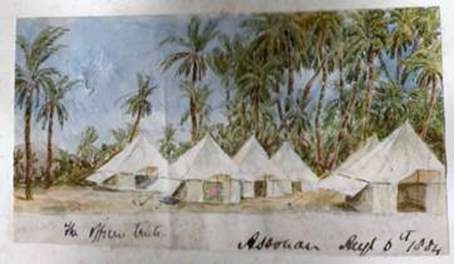
The officer’s tents, Aswan, 6 August 1884
The Gordon Relief Campaign
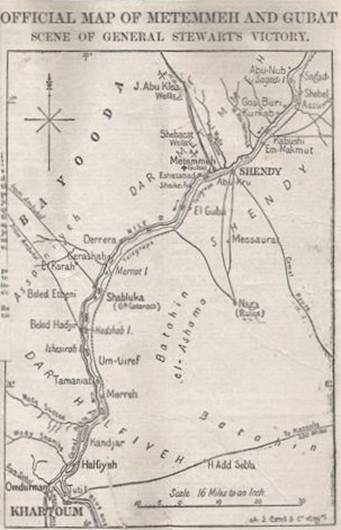
Map of the Gordon Relief Campaign26
Lionel’s account of the Gordon Relief Campaign begins on 23 August 1884, when the Regiment moved to Wadi Halfa. Lionel’s company, C Company, then moved southwards, reaching Serras (the end of the railway line) on 5 September. Two days later, on 7 September, they set sail down the Nile for Dongala, which they reached on 20 September. They camped at Dongala until 14 December, when they moved to Debbah.
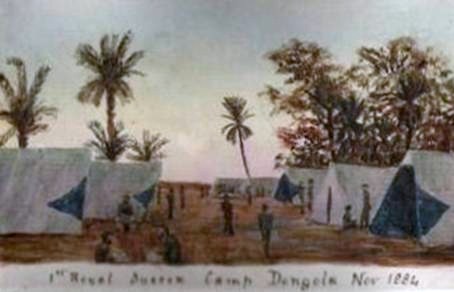
1st Royal Sussex Camp, Dongola, November 1884
On 20 December, they received orders to move to Korti, arriving there on Christmas Day. There they remained until 8 January, when they started their long and arduous march across the Bayuda Desert to Gadkul, arriving there on 12 January.
The march across the Bayuda Desert
Lionel wrote in his diary:
‘Every man started in the highest spirit’s the novelty of riding camels amused them the expectation of seeing some hard fighting excited them while the fact of being the only infantry regiment chosen to cross among the first troops put them terms(?) with themselves. As soon as we marched at ease every man pulled out his pipe and chatted away as if it were a bank holiday entertainment. How soon were the pipes to be put away never to be lit again [til] the desert was crossed and water was plentiful.
…
‘On […] Jany 10th we left at 3 am; at 9.30 we got to the well of El Howeyat and halted. There was very little water to be got but some of the men got a canteen full, it was full of sand and was as thick as pea-soup, at 2 pm we started off again and bivouacked at 9.30 pm. The men were thoroughly done up every man without waiting for his tea threw himself down anywhere and after one or two of us had made it it was with the greatest difficulty we could rouse them to drink it. Our water was getting very short. Every man carried on his camel a mussock i.e. a goat skin full of water and a leather water bottle holding about a quart; many of our water skins leaked so we found ourselves with much less than we estimated. My Company had been more fortunate than others, either the skins were better or the men did not have surreptitious drinks – probably both. Another Company on the other hand was almost water-less. On the evening of the 9th my company gave the other one a pint per man. To those who do not know what thirst is this will seem a small thing, but wait until you have hardly dared eat anything for two days because of your thirst, ride 13 hours in a boiling sun on a rough camel have a good suspicion that those who you are giving your drink to you (sic) have drunk their water on the sly be nearly mad with thirst at the time yourself and you will appreciate the feeling that animated these 70 men to give up without a single complaint except from one solitary man.
…
‘The march had been very trying. If you put a common soldier on a camel in any country and load the camel so that he could not be very comfortable and make him ride for 12 or 13 hours a day he would be pretty tired at the end but if you add to this want of water salt provisions and a hot sun you make a tremendous call on his endurance.
Battle of Abu Klea27
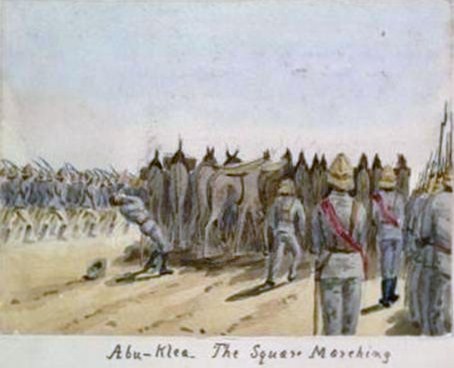
‘On the third day from Gakdul (the 16th Jany) we left our bivouac at 2 am and halted from 11 to 12.30 in the day. Soon after we had resumed our march the cavalry reported the enemy in strength at Abu Klea wells. The four companies of the regiment were dismounted to form an escort on the G(?). At 2 pm after passing over a hill we halted in a valley and made a Zereba.28 The enemy soon began firing at us from the front and up front. I and my company were sent off on outpost duty on a hill on the left and a bit to the rear. The firing became pretty smart just at sundown and I made a parapet of big stones to protect my picquet and cover it over with our blankets to prevent the splinters flying. The enemy during the night worked round on the hills from the right towards the rear and I expected to have a brush with them but they did not ascend my hill. During the whole night the Arabs marched about beating their tom-toms; sometimes they appeared to be quite close and then to vanish away into distance. We were well on the alert with the tom-toms on our front and sharp-shooters in our right rear.
‘At daybreak I was recalled to the Zereba leaving Lieutenant Jones with about 15 men on the hill. As I marched in I saw a young Hussar lying down shot through the head – it had begun in earnest. At about 10 after having in vain attempted to draw the enemy on to attack us in our Zereba – it was a very bad one he might well have done it – we formed up in square on the right. G and C Corp with Sunderland and myself went onto the square. The rest (?) of the 1/2 batn remained in the Zereba to protect the convoy. Soon after 10 we marched out under a hot fire from the front and right. We had to march down a valley and the hills on the right were very favourable for sharp shooters and the Arabs made good use of it.
‘We had scarcely left the Zereba when their shots began to take effect. Poor Gough who had been with us at Abasiyieh fell almost immediately it seemed to me that he was struck in the head he seemed to spin round once and then fell. As each man fell the few words “Man down” was called and the doctors with one or two Army Hospital Corps ran to him; If life was left a camel was halted and the wounded man was put on it; the square by this time would have got 50 or 60 yards, so the rear face was constantly being broken by camels going in and out. As the square advanced the enemy’s sharpshooters on the right kept up with it firing from behind the numerous rocks and stones that were on the hill; their range was roughly 500 yards. As no orders were given to send out scouts to cover our flanks individual commanders took the responsibility of doing so. After our scouts were out we did not suffer so much. MacSorley D Coy attached to ‘C’ was sent flying out of the rank struck in some vital place he fell at least two feet clear of where he was marching. The square was not in very good order, the right face was very crowded and the left very thin, this might be from the front and rear faces not being parallel; the rear face was constantly being broken by the camels.
‘A little before 12 on our left front over the brow of a slight ridge we saw a sea of standards. These we knew were the spearmen; in order to get clearer ground to fire over, the square moved half right and halted on the top of a slight incline. The position was perfect but for a wady which gave the enemy cover about 200 yards off – this wady also had the effect tho’ of breaking their ranks as they charged. When the Square halted, the left face that exposed to the enemy was very thin while the right flank where we were was in one part four deep. Seeing this Major Sunderland went to General Stewart to obtain permission to march his company to the left face. Suddenly the bank opposite about 350 or 400 yards off was a black mass of charging spearmen. In the van were a few horsemen perhaps a hundred or more; in an instant the left face opened a rapid fire and the rear composed of the heavy camel corps in their eagerness to get engaged left this position, first by twos and threes and then en masse, and prolonged line to the left of the left face. Colonel Sunderland having got permission without my knowledge to take his company to the left flank shouted out to them do go there, but I not knowing his order stopped them and with them and my own company formed a new rear face – the rear face being nearly entirely open from the heavies prolonging the left face.
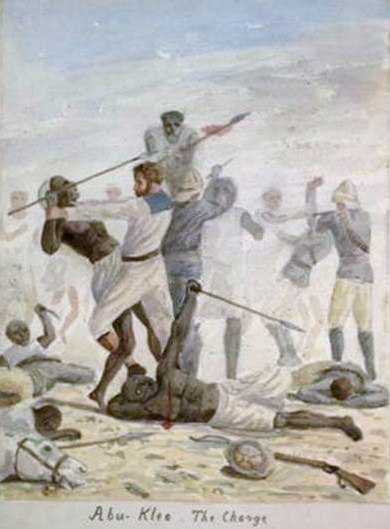
‘In spite of what ought to have been a murderous(?) the Arabs came on lapping round the exposed left flank of the Heavies they seemed as if they would annihilate them. Finding themselves attacked in front and flank the heavies who belonged to rear face retreated back to their proper place and came on the top of our men with the Arabs on top of them: the left face was very hard pressed being in places broken and it gradually retired, leaving the rear face less ground to cover; the confusion was getting terrible my men were borne back by the superior wait (sic) of the Heavies. The Heavies fought hard but kept losing ground, their firing was very wild. Many men, I saw, were firing in the air from their kepi. For once in [a] way my smallness was useful and I managed to creep into front rank and tried to make them fire low and keep their ground, and soon found myself outside the square; I did not stop there very long and on getting back into the ranks I got squeezed up against two huge dragoons lifted off my legs and carried backwards and forwards as the square waved, I could use my arms enough to use my revolver but that was all.
‘The Arabs charge was a glorious sight; trained as infantry are to believe that unless it has been broken with fire nothing can approach it over clear ground we believed that no Arab could get within a hundred yards of us, we thought they were charging to certain death yet they not only reached the square but penetrated it; this was in a great measure owing to the random shooting of the Heavies. It required the bravery of the Arabs even under these circumstances to have done so. As I said before the fiercest charge was made at the left face and it was against that part that the majority of the horsemen went, some came against us. One especially I noticed he evidently had intended charging the left face but his horse shied and I saw him come across our front pulling hard at the near bit to get his horse at the square. The horse had his mouth open and his neck bent towards us but was galloping across our front. Suddenly the rider got him in hand and turning his head dashed the shovel stirrups into his flanks and came at the square alone. When he was about 30 yards off his horse fell but the man sprung up and dashed at the square, only to fall wounded and then on his hands and knees he crawled up that if possible he might kill one man before he died – he died a yard from my feet he had raised himself for his last effort.
‘All this time the left and rear faces were gradually closing in; sometimes I was on my feet sometimes off. Things were looking desperate. Soon I expected we should have backed on the front face, when a cheer rose from the square and we advanced. Many lay claim I expect to starting that cheer and probably it arose simultaneously to more than one pair of lips; until I heard others lay claim to it I thought I was the first and I cheered in hopes of sending the rear face forward again, but as I said before it is probable that no one man started it.
‘The face of the square now pulsed forward and we saw the Arabs were retiring, not running but swaggering off. The cease fire sounded and all was quiet. What a great charge had gone on in those few minutes all had been excitement a terrible noise of rifles firing Arabs yelling and our men shouting and swearing and then a sudden calm and on looking around the whole desert for many yards was covered with dead and dying bodies. There was not a sound, within those few yards what torments of agony were being suffered but not a groan escaped from Arab or Englishman. Now and them a limb might be moved but beyond that all was still among the dead and dying; a little further on were a couple of horses and one or two camels riddled with bullets but still standing. To notice all this was only the work of a second suddenly the calm was broken by a sharp rapid fusilade and all was calm again – two or three dozen Arabs who were hidden in the Wady had tried a charge on their own account that was all.
‘Then came the mournful work of collecting the killed and wounded – the square having been previously informed. When the rear face retired the camels got outside the square and were almost all killed with I am sorry to say in many cases our wounded who were on them; the consequence was after all the ammunition was issued out that the men could carry we made a bonfire of the rest, drank all the water and started for the hills of Abu Klea.
‘Knots of Arabs watched us from the surrounding hills but we dispersed them with the Gatling and our gun. We arrived at the wells at 6, in no order laid down in the drill book and could not have shown any real front, but our enemy was too much beaten to among us (sic). We had to find an outlying piquet. Sunderland being our Commanding Officer I was the only officer available. Having been on piquet the night before I was pretty well done up so he did it for me. It was a cold night we had no great coats and no blankets so we burrowed holes in the sand and slept some-how’.
Commenting on the Battle of Abu Klea, Henry Keown-Boyd in A Good Dusting notes:
In Told From the Ranks, published in 1897, Harry Etherington, of the 1st Battalion, Royal Sussex Regiment, provided an equally vivid account of Abu Klea:
…Then commenced a night of terror. We formed a zereba of bushes and crouched behind it; many a man prayed that night who was not in the habit of doing so, I can assure you. You see it is one thing to face a foe in the field, and quite another to lie awake at night expecting to be killed every minute. All the while the Mahdists kept up a desultory firing – for they had two thousand Remingtons, captured from Hicks Pasha – and we lost several men and a number of camels.
…
The next morning we had one of those glorious sunrises that are only seen in the tropics. At eight o’clock we again formed a square, for the Madhists were beginning to descend from the hills. We sent out skirmishers to attack them, and Lieutenant de Lisle was shot while we were forming square.
…
We were only two deep in square till within fifty yards of the enemy, when our skirmishers retired, and we opened square to let them in. At that moment the Mahdists charged, but were repulsed. A second charge failed, but at the third they succeeded in breaking one corner of the square, and then the position became very serious indeed. Probably their success was due to the fact that our men at that corner were not used to the bayonet but to the sword. Anyhow the Soudanese broke a British square, and that is something to their credit.
Our seven-pounders were thus left outside, and Colonel Burnaby rushed out of the square to recapture them. He fought like a hero but was thrust in the throat by a Mahdist spearman and killed. We dragged him back to the square but it was too late.
It was at this point that Gunner Smith won the only Victoria Cross of the campaign. When the square was broken, Major Guthrie stuck to the guns, and fought till he fell wounded. Then Gunner Smith rushed to the rescue. He had lost his rifle, but he caught up a gun spike, beat off the Soudanese, and dragged the Major back into the square.
When the square was re-formed a lot of the Mahdists were inside, but you may be sure that none of them lived to get out again. One odd incident happened inside the square. We were carrying a number of chests of bullion for Gordon, and these were knocked open in mistake for ammunition, so that the ground was literally strewn with sovereigns.
At last the Gatling guns were got into action, and that practically ended the battle. The Soudanese were simply mown down. Their bodies flew up into the air like grass from a lawn-mover. But their pluck was astonishing. I saw some of the natives dash up to the Gatling guns, and thrust their arms down the muzzles, trying to extract the bullets which were destroying their comrades! Of course, they were simply blown to atoms…..30
Metemmah
Lionel continued in his diary:
‘The morning of the 18th was spent filling up our water skins and bringing up the convoy. At 4.30 pm the column marched off leaving B and F Coy of the Regiment under Major Gerus to guard the wells. We started on our night march in high spirits, we knew that we had been pitted against the Mahdi chosen troops and felt that any opposition between us and the Nile and perhaps Khartoum would not be great; we thought Gordon was as good as saved. It was a very tedious march, the pace was slow and the halts to prevent stragglers frequent. I think most men slept on their camels during some parts of the night. At daybreak we found ourselves passing thro’ a broad belt of mimosa trees; men of all corps were hopelessly mixed, those on quick camels had got to the front while those on slow ones in the rear.
‘At daybreak we halted and reconnoitred but for some time very little was done to reorganise our line of march – individual officers tried to collect their men but it was a hopeless job until the order to reassemble was given. At length we were formed up again, and continued on our march after having halted for about an hour. A little before 8 am we found the enemy in front of us in force and I was ordered to form a Zereba with my Company round a portion of the convoy. By degrees other Corps were sent to my Zereba (the Zereba was made with camel saddles) and it grew to the principal one. Of course my camels being down first got hopelessly mixed with the others and my men could get at neither their rations or water. All round our right front was desert grass and bushes and very soon we saw puffs of smoke coming out from this quarter. We skirmished a few a hundred yards or so towards the grass and fired at the puffs – for men we could see none. I doubt if we did them much damage, whereas most of their shots took effect in our crowded Zereba. Very soon General Stewart was badly wounded and it seemed as if our commanders were paralysed for hour after hour we remained there in a dense mass for the enemy marksmen to fire at.’
Keown-Boyd notes:
… at some time between 10 and noon Stewart was severely wounded in the groin. The wound was mortal and although he did not die for several weeks, he was obliged to hand over command to Wilson immediately. However, he was fully conscious and able to confer with Wilson and Boscawen.31
‘About midday I began to feel pretty thirsty and hungry so I got some rations from a friendly commissariat sergeant for myself and men and we helped ourselves to what water we could get. The bullets fell pretty thick into the Zereba, the camels suffered most but they did not seem to mind much. A camel who was kneeling close to me got a bullet in the head he only gave his head a shake. At about 2.30 we were ordered to form up in square on the right of the Zereba. My position was in the left half of the rear face next to me came Sunderland beyond him the Heavies. On the left face were the Mounted Infantry. About a couple of minutes after we had marched off we were halted, my company was unfortunately on the ridge of a sand hill. Just that moment the enemy gave us a volley the ground seemed torn up all round with bullets. I looked back to see how my company had fared and I saw about a dozen on the ground – only two were killed of the rest some were badly hit and some only grazed.
‘The order was to march in slow time to prevent the square being disorganised and the object of our Commanders was to avoid the rough grass ground to pass by the enemy’s left and to receive the charge when it came on the infantry. To accomplish all this it required a lot of manoeuvring and this had to be done under a hot fire. We constantly halted and gave the riflemen in the grass volleys and I imagine killed many of them. The square was well manoeuvred, the rear face of course was constantly broken by camels stopping for the wounded – it was also rather harassed by an officer in the Household cavalry who happened to be senior to Major Sunderland, taking command and giving words of command that do not appear in the book; he commenced by trying to make the rear face march in fours and not content with giving many words of command he abused the men for doing right. The enemy seeing that we were bent on passing by his left and sticking the Nile south of Metemmah waited until we were opposite his flank and then charged. It was a very different thing from Abu Klea; now they were charging against infantry and as fast they came over the ridge they were posted behind they fell in heaps. I saw no man get within 100 yds of the Square. No sooner had the spearmen been defeated than our rear was threatened by horsemen. The officer who had taken command of the rear ordered us to fire a volley but giving the word ‘Fire’ before ‘Present’ the volley was a failure. However it frightened the horsemen and the battle was over. We halted for a short time and I looked over the brow of the hill and saw streams of Arabs going back to Metemmah. Evidently everybody had turned out to see the fun but there were 3 or 4000 troops marching back who had not been engaged.
‘We continued our march in very fair order; the horsemen who we knew were somewhere about kept the men pretty well in the ranks, but we were all done; we had marched all night and had been fighting all day and few of us had had a real meal or enough water. Still we marched on – it was getting dark were we never going to reach the hill; it was behind every sand hill but when we got to the top it was only to see another ridge. It got dark and still we were toiling on, tired thirsty and hungry we could hardly drag our feet out of the deep sand . Oh if those few thousand Arabs who had returned to Metemmah had only known their chance – perhaps in the face of danger we should have found strength but a charge like that at Abu Klea must have overthrown us. At last we mounted the last ridge and saw the Nile reflecting back the cloudless sky, it was just beneath us and in a few minutes more we were on our hands and knees drinking as hard as we could. Then came the hunger but where were the rations, as I said we were separated from our camels and so could not bring anything. I asked Colonel Bascowen of the Guards who had brought two days rations with them, and he kindly said I might have one of them but we found out that the camel carrying the other days ration had been killed in the square so I and my men lay down supperless. How I did sleep soon after I went to sleep our men were moved to another position but as they could [sic] wake me they left me alone and I was surprised to find myself among the Guards when I woke in the morning.
‘On the 20th Jany we occupied a village between us and Metemmah, placed it in a state of defence and made it into a hospital, the convoy was brought up. On the 21st Metemmah was attacked in Square from the side near the river; Gordons steamers came up and his men assisted. A gun or two having opened on the square it retired. Our two companies were left in charge of the Hospital.
…
To Gordon’s rescue
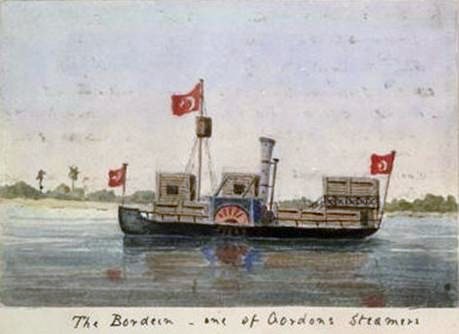
Too late! Too late to save him,
In vain, in vain they tried.
His life was England’s glory,
His death was England’s pride.32
The steamers selected for the Khartoum “trip” were the Bordein under Khasm el-Mus and the Talahawiya under Abdel Hamid, also a Shaigi and a relative of Khasm’s. Wilson himself and one of the two officers who had been chosen to remain in Khartoum with Gordon, Captain F.R. Gascoigne of the Blues, sailed in the Bordein accompanied by a sergeant, a lance-corporal and eight men of C Company 1st Battalion, Royal Sussex, and Wilson’s batman, Driver Sutton RE. Also on board were another prominent Shaigi, Mohamed Bey Ahmed, Sheikh Mahmud, “a great religious sheikh from Kassala”, and by no means the least important, Wilson’s interpreter, Mohamed Ibrahim. In addition to the Sussex detachment there were one hundred and ten Soudanese soldiers.
In the Talahawiya was Captain L.J. Trafford, commanding C Company 1st Royal Sussex, with a corporal and nine men. The other officer to remain in Khartoum, Lieutenant the Hon E.J. Montagu-Stuart-Wortley, his batman, a Royal Naval artificer, a signaller and a contingent of eighty Soudanese were also on board.
…
Captain Trafford had selected the Sussex men, all from C Company, for their steadiness and marksmanship. It seems that he chose well, as no less than four received the Distinguished Conduct Medal for their roles in the perilous adventure to come. Wolseley had stipulated that the British troops on arrival at Khartoum were to wear their red coats, for it was in this highly unsuitable garb that the Empire had been won and held and he believed the psychological effect on the Mahdists might be decisive. Unfortunately the red coats of the Sussex had been left somewhere along the way and they had to borrow some red jerseys from the Guards, many of which would have completely enveloped the borrowers had they ever worn them, a point about which there is some diversity in the various eye-witness accounts33 34
Lionel continued:
‘On the 23rd I received orders to embark with 20 men that night on board two of Gordon’s steamers the Bordein and Tellahawiye. We had started from Korti with 20 red serges in our baggage so that we might go up in red but nowhere could these serges be found. During the night march from Abu Klea the orders were that any camel carrying anything other but ammunition or provisions that should fall on the way was to be left with its load; if the load consisted of ammunition or rations it was to be transferred to a spare camel and I imagine that our red serges must have been lost during that march. Our men were ordered by Wolseley to go to Khartoum but his orders also said that the men going there were to be dressed in red. The Heavies and Guards had red, they agreed that since we had no red, men picked from them should go, but we had one friend on the committee who spoke up for us, Colonel Barrow of the 19th Hussars. He said the Royal Sussex were ordered to go they have done the hardest work and they should[;] the corps with red must supply them with serges. He bore down all their objections and that afternoon I and my men were supplied with red serges. That night we slept on the shore close to the steamers and at daybreak next morning Jany 24 we embarked on the two steamers and sailed at 7.45.
‘On the Bordein were Col Sir Charles Wolseley; Capt Gascoigne (late Blues); Colr Sergt Wellstead, Corpl Othen, Ptes Benford, Dale, Jones, Temple, Gausden, Patching, Leggett and Ings C Company 1st Royal Regiment. On the Telahaweyah, myself, Lieut Stuart Wortley (Kings Rifles), Corpl Smith, Dr Gilbert, Ptes Cowstick, C Paine, Mitchell, Nealan, Cannings, Ings, Poole, G Woods, C Coy 1st Royal Sussex Regt.35 These men were chosen as men who had behaved well during the campaign and because they were good shots.’
At this stage, Lionel’s contemporaneous diary finishes. He continues in his official diary:
‘The steamers were about the size of a London Penny steamboat; they had a deck cabin aft, the top of which was protected with high bulwarks made of railway sleepers and lined inside with iron plates; over the Bridge was built a tower of the same material containing a Krupp gun firing over the sides (?), in the bow there was another tower holding a brass mountain gun; and Bulwarks of the same construction ran right round the ship except in the actual bow and stern. The cover against infantry fire was therefore almost perfect. … there was no protection against guns. The ‘crew’ and ‘soldiers’ were a motley … accompanied by a proportion of wives and a vast amount of baggage.
‘The natives began firing at us from the left bank on the 25th and continued to do so every day; now and then for amusement we answered them if we could see them. On the 25th and 26th we were passing up the 6th cataract; in one place where the water was very bad and the river very narrow, with rocky hills coming right down to the water, we expected to be attacked but met with no opposition. On the 27th we had gained the top of the cataract and tied up south of Jebel Royan.
‘As we expected to reach Khartoum on the following day we laid in an extra amount of wood in case the town should have fallen and it should be necessary for us to steam back. We obtained wood in our usual fashion by pulling down houses and breaking up water wheels. During the afternoon a native on the right bank told us that he had heard that the city had fallen and that Gordon was killed.
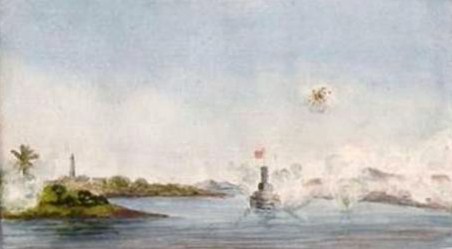
‘On the 28th we started at 6 am the natives fired at us from both banks. A friendly native on the left bank told us that Khartoum had fallen and that Gordon was shot. Our fears for Gordon were great; there were very little means of communication between the two banks as all the native boats had been destroyed, yet from both sides we heard that Gordon was dead. As we got near Halfiyah the fire from both banks increased. The Telahaweyah was leading by about 50 yards; our natives were firing wildly but we reserved our fire. Just below Halfiyah the enemy opened on us with shell. The gun nearest us was in a waterwheel cutting, the range commenced at about 800 yds and lessened to about 500 when we were directly opposite. The bank was white with musketry but we only fired at the gun; one shell burst in the water a few yards off and covered us with water and the fragments fell among the men without hurting anyone, the fuse still burning was thrown overboard by Dr Gilbert. Our men fired with great steadiness and by the time we were opposite the gun its fire was subdued.
‘The Bordein with Sir Charles Wilson on board now overhauled us and passed between us and the bank masking our fire. The Bordein at once engaged two more guns higher up. As soon as our front was clear we opened on them also and they soon ceased fire.. However the first gun we had passed began firing again. The stream was strong and our progress slow, about 3 knots an hour; after passing Halfiyah there was a lull but off the Island of Tutti just below Khartoum, the work got very hot again. We kept close under the island to give Omdurman, where the main body of the Arabs and several guns were, as wide a berth as possible. Tutti was held by the enemy and we got into action with them at about 80 yards range and did good execution but our serious work was with Omdurman for from there in spite of the range being over 1000 yards a constant stream of bullets went singing over our heads or rapping up against our well protected bulwarks. The shells gave us a little anxiety for from them we had no protection; one cut a nuggar the Bordein was towing, down to the water; another crashed through our hull above the water line without however bursting.
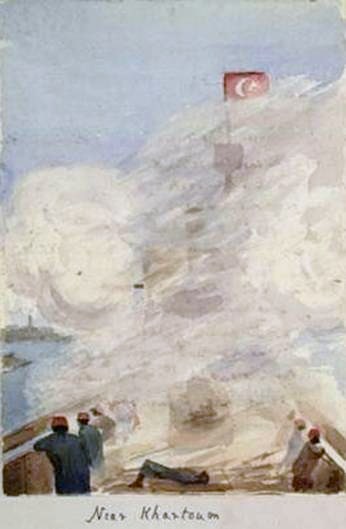
‘As we rounded the point of Tutti we saw Khartoum with hosts of Arabs under the wall, no Egyptian flag flying and one or two guns firing at us. It was too true Khartoum was lost so we turned about and ran the gauntlet again past Halfiyeh and tied up at 5.30 to(?) an island some miles below. A party of the enemy came on board with a letter from the Mahdi requesting us to hand over the steamers and become Mahommedan.’
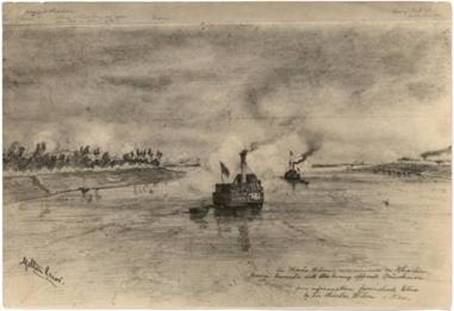
‘Severe encounter with the enemy opposite Omdurman’
(Melton Prior)36
Thomas Pakenham in The Scramble for Africa writes:
‘On the 29th we began to descend the 6th cataract and the Telahaweyah was wrecked; we transferred everything [to] the Bordein. On the 30th we were still in the cataract after letting the steamer down bad (?) places with hawsers. On the 30th just after we passed the last “gate” of the cataract the Bordein struck a rock and immediately began to fill; we beached on a sand spot near the Island of Mernot. We crossed over to the Island on the 1st after having sent Lt Stuart Wortley down to Gerbat in a boat manned by natives with two men of the Royal Sussex before to report our mishap.
‘On the morning of the 3rd from the Northern end of the island I saw a steamer come round a distant bend in the river and engage with a fort Wad-u-Habeshi which was about two miles below us. Suddenly she was enveloped in a cloud of white smoke and appeared to stop. It was evident that she had met with an accident. We put all the baggage and guns into the nuggar, that had been towed by the Telahaweyiah, and floated it down under the command of Captain Gascoigne (late RHG) and we all crossed over to the right bank in a boat. We landed a gun from the nuggar just above the fort, on the opposite bank and opened fire. The steamer was commanded by Lord Charles Beresford and we found that just as she had passed the fort a shot had penetrated her boiler; the fire of the fort was kept under by a Gardner38 and the infantry; they reported that by daybreak next morning it would be mended.
‘We bivouacked on the bank a few miles down. The nuggar under Gascoigne with Corpl Othen, Ptes Cowstick, C Paine and Dale of the Regiment, with a few natives who nearly all deserted, was with great difficulty floated down under the very guns of the fort during the night and the steamer having been repaired we embarked and arrived at Gubat on the evening of the 4th. [On] the whole journey to Khartoum and back only two men of the Royal Sussex were wounded; two or three natives were killed and one or two wounded.’
Keown-Boyd concludes:
This daring adventure, had it been successful, would have made Wilson and his men national heroes. That the two steamers had survived the one-hundred-mile journey through largely enemy-held territory to Khartoum is remarkable enough. That almost the entire force had returned eleven days after its departure, albeit without its steamers, is nothing short of outstanding. Few lives had been lost and Wilson had managed to hold together a force which by all reasonable expectations should have disintegrated. That he was coolly and bravely supported by the three young British officers and the unflappable Sussex men is axiomatic but great credit must also go to Khasm el Musa and the native troops and sailors who remained loyal to Gordon, even after his death, despite every temptation to do otherwise.39
Aftermath
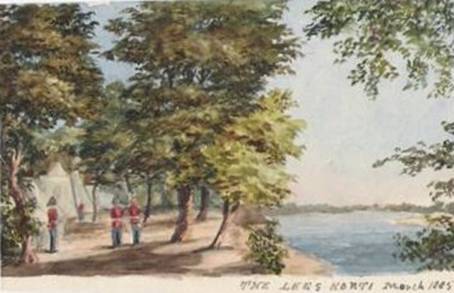
The Legs, Korti, March 1885
The expedition then began its slow retreat, reaching Korti on 10 March and Abu Gus on 24 March, where they remained until 1 June.
‘We expected to move South again during the Autumn to retake Khartoum but as the summer advanced it became certain that any move we made would be towards Cairo. On June 1st we went down to Dongola … On June 17th we embarked again in our whalers and started for Wady Halfa; … On the 27 [we] left Wady Halfa in steamers and reached Assouan on the 29th. On July 5 we left Assouan in steamers and reached Cairo at 9.30 am on the 12th. Having been entertained there by the 2nd Battalion we left at 9pm by rail and arrived at Mex near Alexandria at midday.
…
Instead of receiving orders for home we were told that owing to strained relations between England and Russia our probable destination would be India. A month later we received orders for England and we landed at Portsmouth in the autumn.’
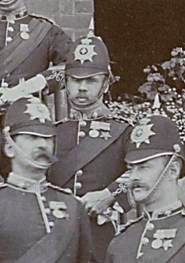
Lionel Trafford (centre),
on his return from Khartoum,
Portsmouth, 188540
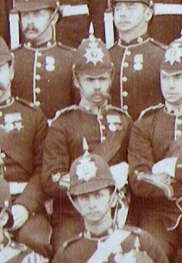
Lionel Trafford, circa 188541
Lionel was mentioned in dispatches in August 1885, 42 one of only three officers from the Royal Sussex Regiment, 43 and received the rank of Brevet Major, 44 and two clasps for his efforts. He left Egypt for England on 11 September 1885.
For all its short-comings the Desert Column had done its best and more. It had ridden, marched, dug wells, built forts and zaribas, sweated, thirsted, steamed, fought and, in many cases, died for nothing. The column had lost fourteen officers and one hundred and fifteen men killed in action, twenty-three officers and two hundred and twenty-three men wounded, a number of whom died later (Sir Herbert Stewart had died on the return journey). In addition, perhaps another hundred had died of disease or exhaustion and the health of many must have been permanently impaired leading to premature death.45
By the end of June 1885, a bitter and frustrated Wolseley had left the Sudan, never to return. Gladstone had fallen from office and the Mahdi was dead. The world… lost interest in the Sudan.46
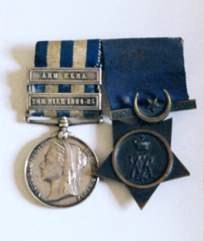
Lionel Trafford’s medals47
Life After Sudan
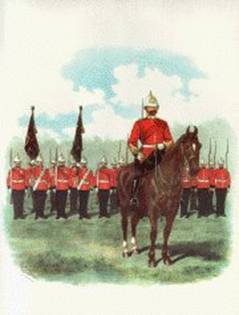
Royal Sussex Regiment by Richard Simkin (c 1888)
Lionel remained with the 35th Foot for another four years, when he was seconded to the 24th Middlesex Rifle Volunteer Corps as its Adjutant.48 On taking up his appointment, the military columns of The Man of the World noted:49
The Post Office Volunteers may be congratulated on the appointment of Major Lionel Trafford as Adjutant of the corps. This young and distinguished officer of the Royal Sussex Regiment took part in every incident by flood and field of the Nile expedition, with the one exception that he was not at Kirbekin.
…
Lionel Trafford deserved more recognition than he got. He is not only a brave and capable solider, but a good comrade, and the Post Office Volunteers should know and cherish him.
In 1890, on the death of his great aunt, Elizabeth Rawson, Lionel inherited a considerable fortune (‘the Lancashire Estates’), much of which he sold, including Benjamin Rawson’s residence, Darley Hall.50 With the proceeds, in November 1893, he bought a beautiful Queen Anne house in Herefordshire, Hill Court.51
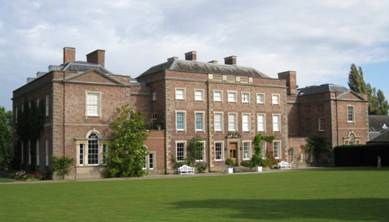
Hill Court
There was now no longer any need to work. In February 1891, he went on retired pay from the Royal Sussex Regiment.52 The following month, on 19 March 1891, he married Amelia Ruth Merton Simmons, an artist and the daughter of Simon Simmons of London.
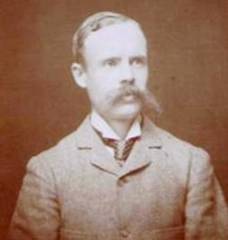
Lionel Trafford
For the remainder of his life, Lionel appears to have lived the life of a country gentleman, concentrating on his life-long love of painting. A number of his paintings were exhibited at the Royal Academy Summer Exhibition.53 Although in May 1899, he was appointed to the 1st Battalion Royal Southern Reserve, the state of his health prevented him from joining.
Lionel died on 20 September 1900 without issue, at the comparatively young age of forty-four, his early death no doubt the latent result of soldiering in unhealthy climates. He was buried with other members of his family in the graveyard of St Michael’s, Michaelchurch Escley.
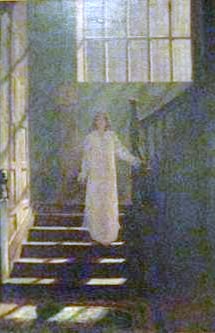
The Somnambulist (1899)
by Lionel Trafford56
Lionel’s wife, Ruth, was distraught by his death. Even six months later, found it difficult to reconcile herself to the fact that he was dead. She wrote to her brother-in-law, Guy:
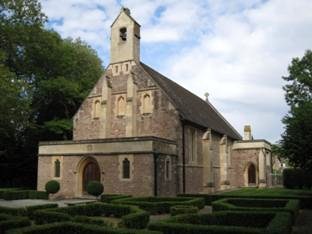
Church of the Paraclete, Hom Green,
built in memory of Lionel Trafford
Ruth built a chapel in Lionel’s memory on the Hill Court estate: the Church of the Paraclete at Hom Green, by the well-known architect, George Frederick Bodley, who had been responsible for the new wing of the Trafford family house, Michaelchurch Court, thirty years before. In the chapel, there is the following inscription to Lionel:

To the glory of God
and to the loved memory of
Major Lionel James Trafford
of the Hill Court, Ross, Herefordshire.
Born November 1st 1855, died September 20th 1900.
Third son of the late Charles Guy Trafford,
J.P. and D.L, of Michaelchurch Court, Hereford.
He was a Major in the 1st Royal Sussex Regt.
and served with his battalion from 1882 to 1885
in Egypt, and took part in the march across the
Bayuda Desert and in the battles of Abu Klea
and Metemmeh, and was specially chosen
with twenty men of his company to go with
Sir Charles Wilson as an advance party to
Khartoum to demonstrate to Gordon that the
English Expedition was on its way to his relief.
He was awarded a Brevet Majority
the Medal with two clasps
and the Khedives Bronze Star.
He is buried at Michaelchurch, Hereford.

To the ever dear and loved memory of
Major Lionel James Trafford whose
Life was so noble, brave and true. This
Church is built by his sorrowing widow.
“Great loss to all that ever did him see
Great loss to all but greater loss to me.”
- RSR Museum Acc 2780 p23, West Sussex Record Office ⏎
- Man of the World, 25 May 1889. Quoted in Lionel’s obituary in local newspaper cutting, likely The Ross Gazette, 27 September 1900. ⏎
- Winston Churchill, The River War (1899), pp 44-45. ⏎
- ‘and to dramatize it further still twenty men on board the ship were dressed in scarlet – the last British soldiers ever to wear the red coat of Empire into battle.’ Jan Morris, Heaven’s Command (1973), p 512. ⏎
- See, notably, Sir Charles Wilson’s From Korti to Khartoum (1886). ⏎
- Henry Keown-Boyd, A Good Dusting. The Sudan Campaigns, 1883-1899 (1986). ⏎
- In the possession of Roland Trafford-Roberts. Roland’s father, Lt-Colonel David Trafford-Roberts, passed a photocopy of what the album to the Royal Sussex Regiment. They are now, together with the official diary, with the West Sussex Records Office. ⏎
- Letter from Lionel to the Colonel of the Regiment, 13 September 1892. West Sussex Records Office. ⏎
- In the possession of Roland Trafford-Roberts. ⏎
- Where his father, Captain Charles Guy Trafford, was posted with the 2nd West York Light Infantry Militia during the Crimean War. ⏎
- Both photographs are from Lionel’s photograph album (in the possession of Roland Trafford-Roberts). ⏎
- Wellington College School Register. Lionel arrived in the Michaelmas term of 1870 and was in Rev Arthur Carr’s house. ⏎
- Margaret Hunter, Unpublished memoirs (1982). ⏎
- In 1881, Lionel was given an allowance of £400 per annum. His aunt wrote to him, ‘This sum will make you comfortable in your profession and I hope it will please you in your exertions. Letter from Eliza Rawson to Lionel, dated 24 July 1881. Documents F8/V/3 and F8/V/5, Hereford Records Office. ⏎
- London Gazette, 10 February 1874. ⏎
- London Gazette, 3 June 1875. ⏎
- London Gazette, 19 November 1875. ⏎
- From Lionel’s photograph album (in the possession of Roland Trafford-Roberts). Lionel appears to be second from the left in the back row. ⏎
- RSR PH 1-7, West Sussex Record Office. ⏎
- Documents F8/V/3 and F8/V/5, Hereford Records Office. ⏎
- From Lionel’s photograph album (in the possession of Roland Trafford-Roberts). ⏎
- Apart from three months between January-April 1881, when he was in Cyprus. It is tempting to think that during this time he may have met up with his brother, Harry, at that time living in Ceylon as a tea planter, but who returned to England once a year. The boat would likely have stopped in Malta. In March 1880, Lionel was appointed Instructor of Musketry, London Gazette, 27 April 1880. ⏎
- The British presence at Ramleh, east of Alexandria, kept Arabi’s forces occupied whilst the main British force went to Ismailia so as to come into the theatre of operations from a completely different direction. Donald Featherstone, Tel el-Kebir 1882. Wolseley’s Conquest of Egypt (Osprey Publishing) ⏎
- Soldiers of the 1st Battalion, The Royal Sussex Regiment, fighting in Egypt (1882), The National Archive. Lionel is noted as receiving the medal and the Khedival Bronze Star, but (along with the rest of the Battalion) not the Tel el-Kebir clasp. See also newspaper cutting (likely The Ross Gazette), 27 September 1900. ⏎
- London Gazette, 27 November 1883. ⏎
- Daily Telegraph, 30 January 1885, p 5. ⏎
- Four companies of the Regiment (‘B’ Major Harden, ‘C’ Captain Trafford, ‘F’ Major Gerus and ‘G’ Major Sunderland) under the command of Major Sunderland were ordered to accompany the column on its march to Metemmah; D, E and H remained as a garrison under Col Vaudeleur at Gakdul. A coy was present at Korti, it followed on to Korti at the end of Janry. From Lionel’s ‘official’ diary. ⏎
- A zariba is a camp surrounded by a thorn fence. ⏎
- Henry Keown-Boyd, A Good Dusting. The Sudan Campaigns 1883-1899 (1986), p 53. ⏎
- E M Small, Told from the Ranks (1897), republished in T M McGuffie Rank and File (1964). Sussex Record Office RSR/MSS/1/86. ⏎
- Henry Keown-Boyd, A Good Dusting. The Sudan Campaigns 1883-1899 (1986), p 54. ⏎
- Rudyard Kipling. ⏎
- Henry Keown-Boyd, A Good Dusting. The Sudan Campaigns 1883-1899 (1986), pp 61-2. ⏎
- In his account of the Gordon Relief Campaign, (later Admiral) Lord Charles Beresford notes: Khasm-el-Mus was placed in command of the Bordein, and Abd-el-Hamid of the Talahawiyeh. Sir Charles Wilson was to go in the Bordein, together with Captain Gascoigne, 10 non-commissioned officers and men of the Royal Sussex, one petty officer and one artificer Naval Brigade, and no Soudanese soldiers. In the Talahawiyeh were Captain L. J. Trafford, in command of 10 non-commissioned officers and men of the Royal Sussex, one of whom was a signaller, one engine-room artificer Naval Brigade, and some 80 Soudanese soldiers. The Talahawiyeh towed a nuggar carrying about 50 Soudanese soldiers and a cargo of grain for Khartoum. According to Gordon’s express desire, the British troops were clad in red tunics, which, being borrowed from the Guards and the Heavy Camel Regiment, were far from being a regimental fit.’ The Memoirs of Admiral Lord Charles Beresford (1914), p 287. ⏎
- ‘Captain Trafford lists a Private Ings on both steamers but there seems to have been only one Ings in the battalion; therefore there may have been another man whom Trafford mistakenly listed as Ings’. Henry Keown-Boyd, A Good Dusting. The Sudan Campaigns 1883-1899 (1986), Appendix D, p 273. ⏎
- RSR PH 1-10, West Sussex Record Office. ⏎
- Thomas Pakenham, The Scramble for Africa (1991), p 268. ⏎
- A machine gun. ⏎
- Henry Keown-Boyd, A Good Dusting. The Sudan Campaigns 1883-1899 (1986), p 68. ⏎
- RSR PH 1-11, West Sussex Records Office. ⏎
- In the possession of Roland Trafford-Roberts. ⏎
- London Gazette, 25 August 1885 and The Times, 26 August 1885, p 6. ⏎
- The others being Colonel Vandeleur and Major Sutherland. ⏎
- He was promoted to Major (Distinguished Fortification) on 23 August 1887. Document F8/IV/38, Hereford Records Office. ⏎
- Henry Keown-Boyd, A Good Dusting. The Sudan Campaigns 1883-1899 (1986), p 81. ⏎
- Henry Keown-Boyd, A Good Dusting. The Sudan Campaigns 1883-1899 (1986), p 88. ⏎
- In the possession of Roland Trafford-Roberts. ⏎
- He was appointed its Adjutant on 8 June 1889. London Gazette, 7 and 18 June 1889. ⏎
- 25 May 1889. Quoted in his obituary in local newspaper cutting (likely The Ross Gazette), 27 September 1900. ⏎
- Sold by auction on 9 December 1892. Auction catalogue in the possession of Roland Trafford-Roberts. ⏎
- Though not before having tried to buy the old Trafford family home, Swythamley. Letter to Lionel from H Clutton, 9 Whitehall Place, London, dated 27 February 1891. Document F8/V/5, Hereford Records Office. Lionel was a keen genealogist and clearly remained in regular contact with the then owner of Swythamley, Philip Brocklehurst, becoming ‘an old friend’ according to a handwritten note in a copy of Swythamley and its Neighbourhood, Past and Present (London, 1874). The Hill Court Estate was conveyed to Miss Rawson’s Trustees on 1 November 1893 for £53,380 (approximately £3.2 million in 2010) (Memoranda for John Lionel Trafford concerning the history and dealings with the Lancashire Estate devised and settled by the Will of the late Miss Elizabeth Rawson (1943). ⏎
- London Gazette, 17 February 1891. ⏎
- Including The Somnambulist in 1899. ⏎
- Izaak Walton was the author of The Compleat Angler, published in 1653. ⏎
- Local (Ross-on-Wye) newspaper cutting, 27 September 1900. ⏎
- Currently in the possession of Juliet Norman. ⏎
- Letter from Ruth Trafford to Guy Trafford, 6 April 1901. Document F8/V/4, Hereford Records Office. In 1906, Ruth remarried Major Audley Reid Lempriere (born 1871) of the Lancashire Fusiliers. She died on 17 June 1938. The Times, 20 June 1938 and www.ancestry.co.uk. ⏎






